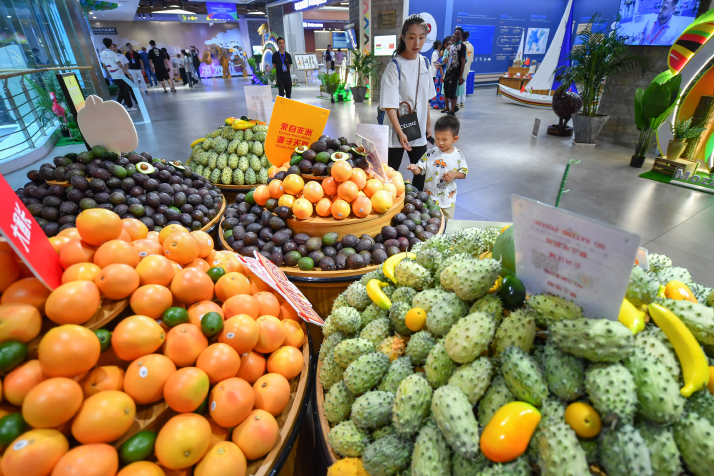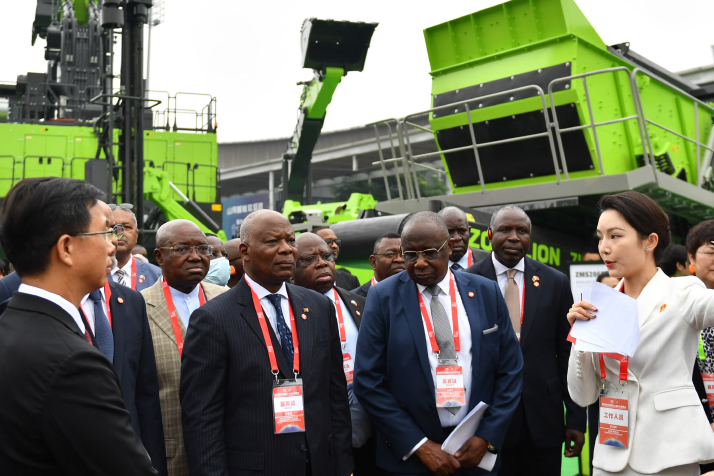| Business |
| From kilns to commerce | |
|
|
 African fruit for sale at the China-Africa Economic and Trade Cooperation Promotion Innovation Demonstration Park in Changsha, Hunan Province, on July 1, 2023 (XINHUA)
From the 50,000 pieces of Changsha Kiln ceramics recovered from the Tang Dynasty (618-907) shipwreck Black Stone to today's weekly cargo flights between China and Africa, Changsha's trade with the African continent has spanned over 1,000 years. This historic cultural city, capital of Hunan Province, is playing an increasingly vital role in China-Africa economic and trade cooperation, with a spirit of innovation and openness. Over a millennium ago, Changsha Kiln ceramics were already being exported to the African continent via the Maritime Silk Road. In 1982, Changsha forged a sister-city relationship with Brazzaville, capital of the Republic of the Congo, becoming a pioneer in China-Africa city-level diplomacy. Today, as the permanent host of the China-Africa Economic and Trade Expo (CAETE) and the core city of the Pilot Zone for In-Depth China-Africa Economic and Trade Cooperation, the city continues to deepen its economic ties with Africa. Innovative approach Data from the Changsha Customs Authority show that Hunan's trade volume with African nations has exceeded 50 billion yuan ($6.8 billion) for three consecutive years, ranking first among all central and western provincial-level regions in China. In 2024 alone, Hunan's imports from and exports to Africa reached 54.85 billion yuan ($7.5 billion). From 2021 to 2024, bilateral trade maintained an impressive average annual growth rate of 14.3 percent. In recent years, Changsha's trade with Africa has experienced rapid growth, now covering nearly all African countries and regions. In the first four months of 2025, Changsha accounted for 53.3 percent of Hunan's 16.66-billion-yuan ($2.3-billion) trade with Africa. The city's imports of African agricultural products surged by 32.5 percent year on year in the first two months, totaling 80 million yuan ($11 million). Behind these promising figures lies Changsha's innovative approach to advancing China-Africa trade ties. One standout initiative is a pre-assessment system for African foodstuffs exported to China, pioneered by the Changsha Customs Authority and officially filed with the General Administration of Customs of China in March. Serving the needs of national platforms such as the Pilot Zone for In-Depth China-Africa Economic and Trade Cooperation, the system allows for early risk assessment of African foodstuffs that Chinese companies intend to import but have not yet been granted market access in China. Simplified entry assessment procedures will be proposed to the authorities to streamline the approval process. This will greatly enhance efficiency, establishing a fast track for African food exports to China. The system is tailored to the unique features of African food safety management and includes a comprehensive database featuring food safety standards, pre-assessment technologies and risk archives. This data-driven approach provides strong technical support for market access evaluations. It will improve both the quality and speed of market access evaluations for African foods, further facilitating a smooth import pathway. The Changsha Customs Authority has pledged to continue supporting enterprises in the China (Hunan) Pilot Free Trade Zone in meeting their import needs and to promote the formation of industrial chains around African non-resource products such as coffee, nuts and meat. Pilot free trade zones in China are designated areas where special economic policies and regulations are tested to promote trade liberalization, investment and economic development.  African diplomatic envoys in China visit the Fourth Changsha International Construction Equipment Exhibition in Changsha, Hunan Province, on May 16 (XINHUA)
A welcoming market In recent years, the Chinese market has continued to open to African nations, welcoming a growing list of African agricultural products. At the 2024 Beijing Summit of the Forum on China-Africa Cooperation (FOCAC), China signed multiple agreements granting market access to African agricultural goods, including fresh avocados from Zimbabwe, soybeans from Zambia and beef and lamb from Namibia. The FOCAC is a mechanism for collective dialogue and cooperation, jointly established by China and Africa in 2000 to cope with new challenges and facilitate common development. Changsha is emerging as a vital gateway for premium African agricultural goods. African specialty products, including dried sea cucumbers from Kenya, lamb from Madagascar and dried fish bladders from Ugandan wild bass, have made their debut in China through the city. In July 2024, Kenyan roses were re-exported from Changsha to Uzbekistan. It was the country's first re-export of African flowers, which further expanded African agricultural commodities' global reach through China. Re-export involves the movement of goods across national borders without the goods being consumed or modified in the country of transit. Three CAETE editions have been held since its inception in 2019, with participation from 53 African countries, including more than 40,000 attendees and representatives of about 4,600 Chinese and African enterprises. The fourth edition is scheduled for June 12-15 this year. Through various supporting initiatives, such as the African Product Brand project, the expo has helped introduce distinctive agricultural products into the Chinese market. Li Guoxiang, a research fellow at the Chinese Academy of Social Sciences, said the deepening of agricultural trade between China and Africa not only enriches dining options for Chinese consumers, but also helps African farmers find new markets for their products and creates more employment opportunities across the continent. "It's mutually beneficial," Li said. At the Fourth CAETE, Changsha's cooperation with Africa is poised to reach new heights. Through its ongoing efforts to remove trade barriers and broaden cooperation, the city is making greater contributions to building a China-Africa community with a shared future. BR This article was first published in ChinAfrica magazine Copyedited by G.P. Wilson Comments to yanwei@cicgamericas.com |
|
||||||||||||||||||||||||||||||
|
